Typical values at TA = +25°C, ADC
Sampling Rate = 2949.12 GHz. Default conditions: output sample rate = 491.52 MSPS
(decimate by 6), PLL clock mode with fREF = 491.52MHz, AIN =
–3 dBFS, DSA setting = 4 dB.
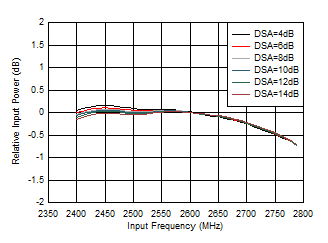
| With
matching, normalized to power at 2.6 GHz for each DSA
setting |
Figure 7-111 RX
Inband Gain Flatness, fIN = 2600 MHz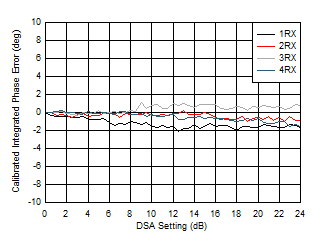
| With
2.6 GHz matching |
| Integrated Phase Error = Phase(DSA Setting) – Phase(DSA
Setting = 0) |
Figure 7-113 RX
Calibrated Integrated Phase Error vs DSA Setting at 2.6 GHz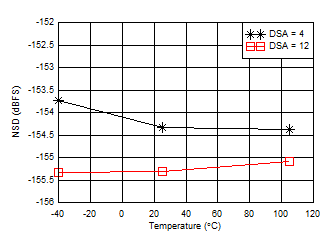
| With
2.6 GHz matching, 12.5-MHz offset from tone |
Figure 7-115 RX
Noise Spectral Density vs Temperature at 2.6 GHz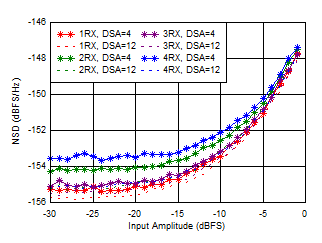
| With
2.6 GHz matching, 12.5-MHz offset from tone |
|
Figure 7-117 RX
Noise Spectral Density vs Input Amplitude and Channel at 2.6 GHz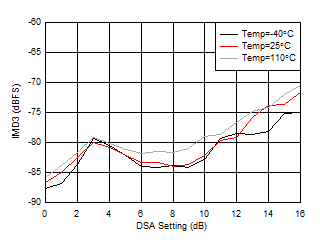
| With
2.6 GHz matching, each tone –7 dBFS, tone spacing = 20
MHz |
Figure 7-119 RX
IMD3 vs DSA Setting and Temperature at 2.6 GHz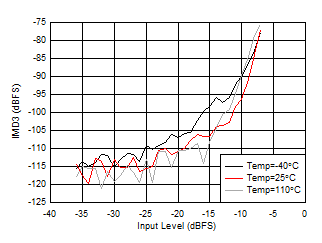
| With
2.6 GHz matching, tone spacing = 20 MHz, DSA = 12
dB |
Figure 7-121 RX
IMD3 vs Input Level and Temperature at 2.6 GHz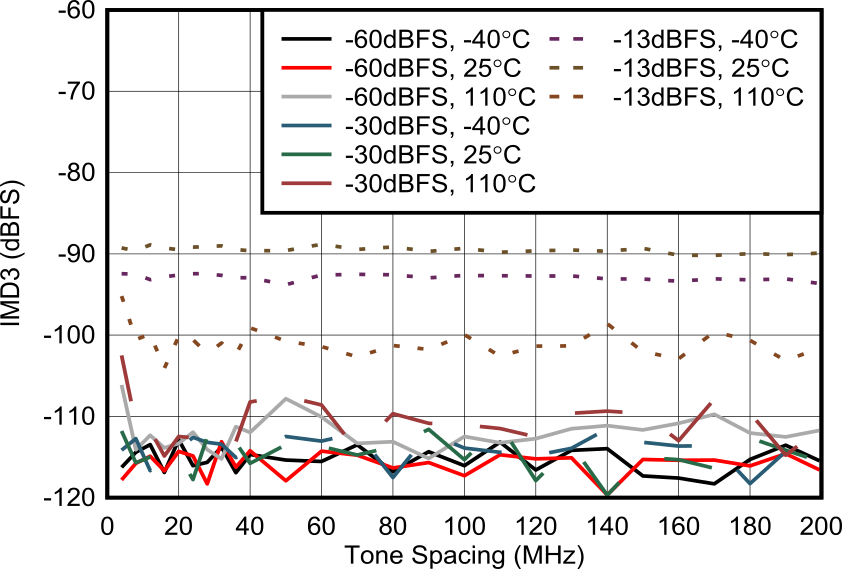 Figure 7-123 RX
IMD3 vs Tone Spacing at 2.6 GHz (Ext. Clock)
Figure 7-123 RX
IMD3 vs Tone Spacing at 2.6 GHz (Ext. Clock)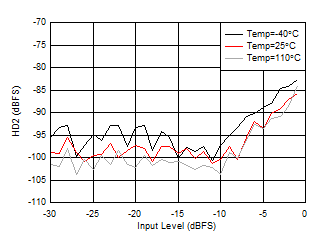
| With
2.6 GHz matching, DDC bypass mode (TI only mode for
characterization) |
Figure 7-125 RX
HD2 vs Input Level and Temperature at 2.6 GHz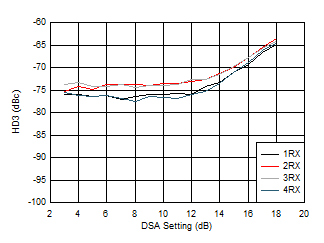
| With
2.6 GHz matching, DDC bypass mode (TI only mode for
characterization) |
Figure 7-127 RX
HD3 vs DSA Setting and Channel at 2.6 GHz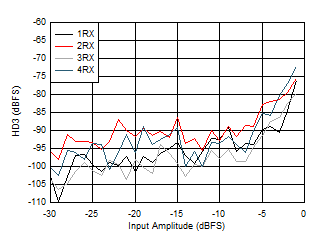
| With
2.6 GHz matching, DDC bypass mode (TI only mode for
characterization) |
Figure 7-129 RX
HD3 vs Input Level and Channel at 2.6 GHz Figure 7-131 RX
HD3 vs Input Level and Temperature at 2.6 GHz
Figure 7-131 RX
HD3 vs Input Level and Temperature at 2.6 GHz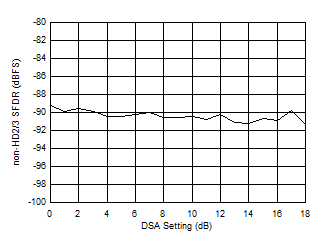 Figure 7-133 RX
Non-HD2/3 vs DSA Setting at 2.6 GHz
Figure 7-133 RX
Non-HD2/3 vs DSA Setting at 2.6 GHz
| With
2.6 GHz matching, –7 dBFS each tone, 20-MHz tone
spacing, all supplies at MIN, TYP, or MAX recommended
operating voltages |
Figure 7-135 RX
IMD3 vs Supply and Channel at 2.6 GHz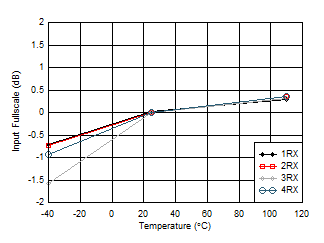
| With
2.6 GHz matching, normalized to fullscale at 25°C for
each channel |
Figure 7-112 RX
Input Fullscale vs Temperature and Channel at 2.6 GHz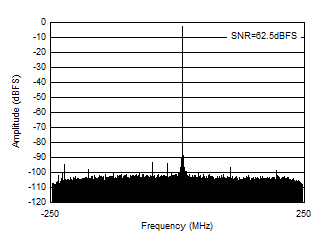
| With
2.6 GHz matching, fIN = 2610 MHz,
AIN= –3 dBFS |
Figure 7-114 RX
Output FFT at 2.6 GHz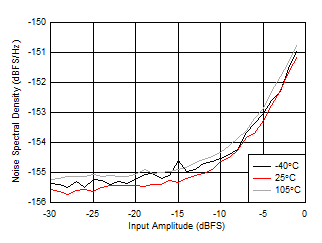
| With
2.6 GHz matching, DSA Setting = 12 dB, 12.5-MHz offset
from tone |
Figure 7-116 RX
Noise Spectral Density vs Input Amplitude and Temperature at 2.6 GHz
| 50-MHz
offset from tone, external clock mode |
|
Figure 7-118 RX
Noise Spectral Density vs Input Amplitude at 2.61 GHz (Ext. Clock)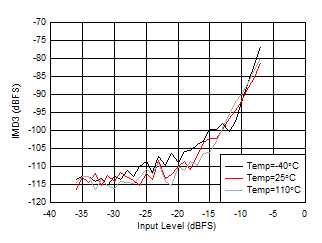
| With
2.6 GHz matching, tone spacing = 20 MHz, DSA = 4
dB |
Figure 7-120 RX
IMD3 vs Input Level and Temperature at 2.6 GHz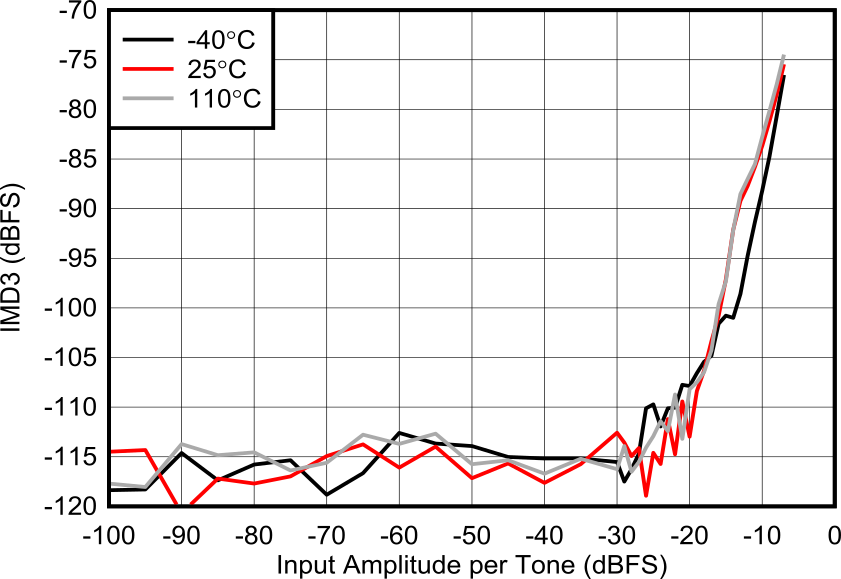
| Tone
spacing = 50 MHz, External clock mode |
Figure 7-122 RX
IMD3 vs Input Level at 2.6 GHz (Ext. Clock)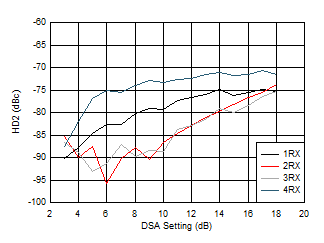
| With
2.6 GHz matching, DDC bypass mode (TI only mode for
characterization) |
Figure 7-124 RX
HD2 vs DSA Setting and Channel at 2.6 GHz Figure 7-126 RX
HD2 vs Input Level and Temperature at 2.6 GHz
Figure 7-126 RX
HD2 vs Input Level and Temperature at 2.6 GHz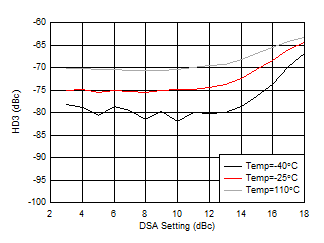
| With
2.6 GHz matching, DDC bypass mode (TI only mode for
characterization) |
Figure 7-128 RX
HD3 vs DSA Setting and Temperature at 2.6 GHz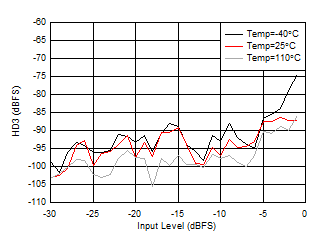
| With
2.6 GHz matching, DDC bypass mode (TI only mode for
characterization) |
Figure 7-130 RX
HD3 vs Input Level and Temperature at 2.6 GHz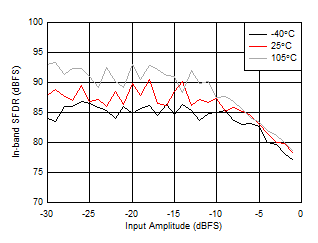
| With
2.6 GHz matching, decimate by 4 |
Figure 7-132 RX
In-Band SFDR (±300 MHz) vs Input Amplitude and Temperature at 2.6
GHz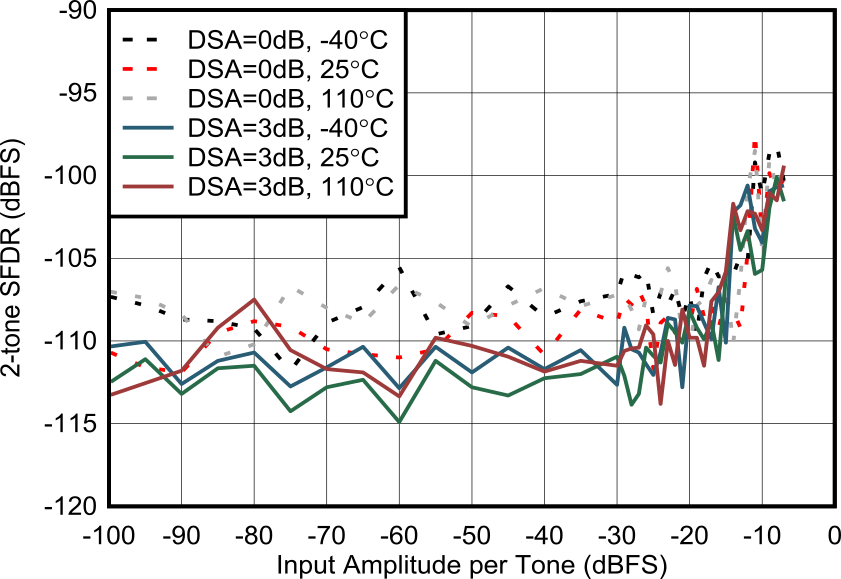
| External clock mode, 50MHz tone spacing, excluding
3rd order distortion |
Figure 7-134 RX
2-tone SFDR vs Input Amplitude at 2.6 GHz
| With
2.6 GHz matching, 12.5-MHz offset, all supplies at MIN,
TYP, or MAX recommended operating voltages |
Figure 7-136 RX
Noise Spectral Density vs Supply and Channel at 2.6 GHz
























